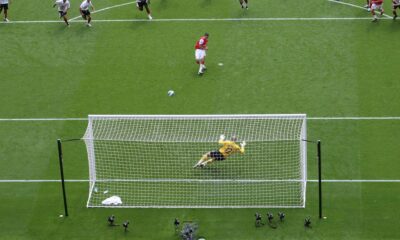Should the Away Goals rule be Scrapped?
Away Goals and Slim Margins: Rethinking International Qualifying
One of the great conundrums of this year, on top of all the other obvious stuff, is that Northern Ireland lost to Norway by six goals both ways in their EURO Qualifying campaign. It was a whopping total of 12, a goal shipped every 15 minutes of the 180 played between them.
Fellow Group C members Wales fell victim to the world-beaters too, but by far slimmer margins. Two goals shipped in total, one slipped in each head-to-head. The last not seen until the hour-mark in Norway’s battering of Jayne Ludlow’s well-martialled defence like some determined mob railing a massive tree trunk into fortress doors until finally a hinge broke.
Wales and Northern Ireland come into Tuesday’s final qualifying fixtures fighting to secure a first-ever major tournament play-off spot. They sit level at 11 points, a goal difference of +9 and -4 in favour of Wales separating them.
Yet, if Tuesday goes as scheduled – if Northern Ireland clinch a win over a Faroe Islands side already privy to a 6-0 thrashing courtesy of Kenny Shiels’ and co. and have yet to register a single goal in the entire campaign, and Wales defeat fourth-placed Belarus once again – Northern Ireland filch the final playoff spot in Group C on head-to-head away goals.
Barring a heady miracle, even the most ardent of Wales fans will feel a stab of what could have been. The away-goals rule always seems to poke an irritating head into the thick of things when you least want it too. A goal is a goal is a goal, unless of course it’s away, wherein it becomes a goal and a half, propelling one team above another based on an old rule we’ve come to simply shrug and accept.
But more recently, it’s become less of an exasperating rash as it has an emphatic nail in plenty of campaigns’ coffins. Manchester City to Spurs in 2019. Diego Simeone’s Atletico Madrid over Liverpool last March. Juventus in August despite Ronaldo’s best heroics. Arsene Wenger semi-famously vouched for its scrapping as far back as 2013: “The weight of the away goal is too heavy, too big and is not justifiable anymore,” he said. “I think it is a problem in the modern game.”
It begs the question: Should performances across the group stage hold more graft than arbitrary head-to-head away goals when the competition calibre has levelled out throughout football?
The international stage wouldn’t recognize itself 30 odd years back, particularly the women’s stage. Tactics have gotten slicker, players tougher and skills sharper. Using head-to-head away goals to decide places in an already thickly competitive group setting undermines the performances consistently put in throughout the campaign. But perhaps most glaringly, it rids the game of the sheer unpredictability that comes with good, competitive football teams. The away-goal rule kept standards high and tournaments filled with the very best. But things have changed.
“I think the games are competitive enough that you don’t have to adjust those rules to ensure that the finals have the better teams in them,” said Jess Fishlock, Wales centurion and Reading midfielder on loan from OL Reign. “We can have surprises now. We can have that in women’s football. The level across the board has gotten better.”
In total, Wales conceded four goals throughout the entire campaign. Northern Ireland conceded 16 goals, gifting goals to every team in Group C save Faroe Islands, who finish without a point to their name and 37 goals conceded. No plaudits should be taken away from Northern Ireland. Eighteen months ago, they ranked 59th in the world and clutched thin hopes at leaping anywhere near the top. Their grit to dredge up wins when required more than warrants their current standing. Wales might have been the only team to come close to prising Norway open, but their tendency to display a shy, toothless grin up front against beatable sides was the prodigal rod in their back.
“You look at the Norway games and think wow we are really, really close, but you can’t not beat Northern Ireland then expect to qualify,” Fishlock said.
Yet, Northern Ireland never technically beat Wales. They drew twice, 0-0 at home and 2-2 away. Spin the locations around, and Wales go through. Flip it back, it’s Northern Ireland. Two completely level scores, two completely different outcomes.
We could make an argument that the women’s game has developed enough to account for a larger pool of qualifiers, something more on par with the men’s game. In this year’s men’s Euros, 55 teams competed for 24 slots; only 16 spots were gifted for the 48 women’s teams to compete. Growing the space for more women’s teams boils down to financial incentives. The surge of women’s football across the world could well see it happen sooner rather than later.
But away goals. Discussable without money on the table.
In its infancy, away-goals held merit when a select few goliaths ran amok on the international stage. It prevented the temptation to bed in, absorb the worst of it, and pray the ball never found the back of the net when on the road. It ensured scintillating football, rewarding the risk-takers and ensuring no small fry fortuitously slipped in. Considering the UEFA Euro winners list, the perception held more than a kernel of truth. Sweden took home the 1984 Finals. Norway claimed 1987. Then Germany flooded in, followed by a 26-year long reign interrupted only once by Norway in 1993. 2017 finally saw a change of flags as the Netherlands lifted the title. 35 years of winners counted on less than one hand.
But that undersells the leaps and bounds competition in women’s football has taken over the last 30 years. Considering just UEFA Euros, in its 1984 inauguration, a four-team event was played with two 40-minute halves. A decade later, matches finally expanded to the full 90 minutes. 1997 saw the competition increased to an eight-team event, with a record 33 entrants split into two divisions. 2009 jumped to a 12-team event. From 2017 onwards, 16 teams competed for the championship, with 48 women’s teams in total bidding for a chance.
The 2017 Euro winners the Netherlands failed to qualify for a Euro slot until 2009. 2017 semi-finalist Austria were riding on the euphoria of a first-ever qualification, having failed to qualify for 20 years previously. Spain have only just qualified in the last two tournaments and made it to the quarterfinals. These teams and others like Belgium, Portugal, Scotland, Northern Ireland and Wales are raising the standard of competition, and yet the game has stayed marooned in rules far exceeding their expiration dates.
If ever a time came when the heft of away matches sits chopped at the knees, now would be it. Away goals don’t stop teams from exploiting tactical craft. A shipped goal on one’s own turf likens to a self-dropped anvil on the toes, leading to home teams playing more drab and self-absorbed football. With no fans in stadiums currently, the threat away games once posed has evaporated. Both Northern Ireland and Wales displayed moments of beautifully horrible and horribly beautiful football. But winding fate down to the chance location of two goals threatens to crumple all of that. There are always two horns on the goat, but sometimes you have to change the goat.




































